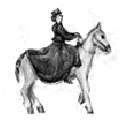
Here are just three of the delightful traditional recipes that you will find, year round, on the menu of every Luton inn or ‘ordinary’ (restaurant). I include many more recipes, fully tested, in my book
Secret Luton and I urge you to reserve your own copy at once!
Luton Llama Neck SoupThe llama neck in this traditional Luton dish can be replaced by kangaroo tail or - in season - by ostrich, armadillo or alligator. (Of course, you could always cheat and use buffalo. It's still delicious!)

2kg/4lb 8oz ostrich neck, cut into joints
½ cup butter
½ cup oil
3 onions
3 carrots
3 turnips
3 parsnips
2 celery sticks chopped, leaves added loose
2 sprigs thyme
A few peppercorns
Cloves, bay leaves and salt
½ cup sherry, port or madeira
½ cup soy sauce (optional)
3¼ pints water
Brown the meat in the butter and oil in a large pot. Add the vegetables (chopped), flavourants, sherry and water. Put lid on pot. Bring to the boil. Simmer for 2-3 hours in a low oven, or until the meat is tender, adding water if necessary.
Remove the meat. Pick the meat from the bones and return the meat to the broth. Cool and refrigerate to solidify the fat. Scrape off and discard the fat.Reheat the soup. Serve with crusty bread.
Luton Lea River Crayfish in LavenderThis delicately flavoured steamed dish based on lavender is unusual because most recipes that involve flowers use them largely as a garnish. Here, the lavender is intrinsic to the dish. You can also adapt this fragrant recipe for any firm white fish, duck, swan, bittern or bustard, adjusting the steaming times.

A few sprigs of flowering lavender
A very large handful of fresh Lea River crayfish
2 tbls butter
1 tbls flour
salt & pepper
Put a few sprigs of flowering lavender at the base of a steamer and place the crayfish in the top. Steam for 5-8 minutes or until the fish is tender and juicy. Keep warm.
Melt the butter in a saucepan, stir in the flour and cook, stirring, for 2 minutes. Pour in enough of the lavender-flavoured water from the steamer to give a sauce, boil and simmer for 5 minutes. Season to taste.
Cover the crayfish with the lavender sauce. Decorate with sprigs of flowering lavender. Serve with broccoli and wild rice.
The blossoms from many flowering herbs could be used in place of lavender.
Chickweed Soup With Yogurt
Did you know that the common weed chickweed equals water cress in its vitamin and mineral content? And the leaves are sweetly delightful, chopped in salads, sandwich fillings or briefly steamed with spring onions, nutmeg and lemon juice - as a bed for poultry?
This simple soup is just one of
countless ways to eat chickweed. Luton folk find it very useful during the three winter months when the great watercress beds at Harpenden are turned into ice rinks for the village children. Chickweed can be found beside one’s own kitchen door, year round!
1 pint vegetable stock
2 chopped sauteed onions
1 cup of chickweed, steamed for 10 minutes and pureed, or finely chopped
1 tbsp fast-cook rice
1 tsp fresh chopped herbs of your choice
Add all the above to a saucepan and simmer for 15 minutes. Pour into individual bowls and lace with yogurt.
Variations: add chickweed to any salad dish which you might garnish with cress or to any cooked dish that calls for chopped green leaves eg. minestrone soup or vegetable casseroles.
 Chef’s tip
Chef’s tip: Luton folk often substitute
sunflower seed ferment for yogurt. This is easily made. Simply grind up dried sunflower seeds and blend them with water into a thick paste. Add a dollop of fresh yogurt as a starter. Put in a warm place overnight, just as if you were making yogurt.
The result is a delightfully tart and very nutritious ‘curd’ that you can use exactly like yogurt, and you don’t need a cow!
Important note: strip the chickweed leaves first from the more fibrous stems. And take care
not to confuse chickweed with spurge. It appears somewhat similar, especially when young, but it has larger shiny leaves. Spurge soup (I can personally attest) has devastating laxative properties.
































CRX.jpg)


















